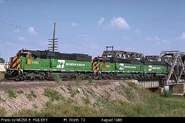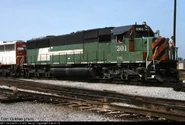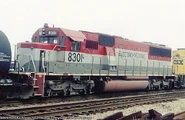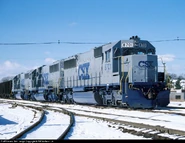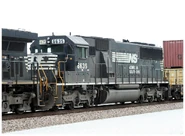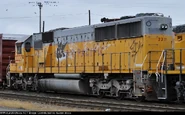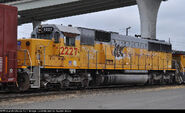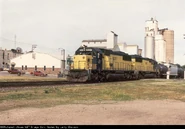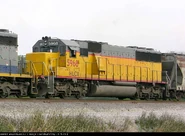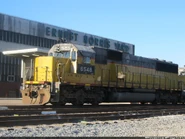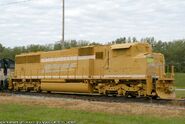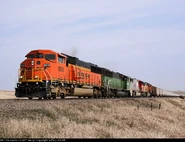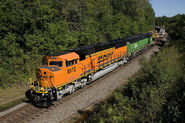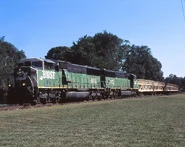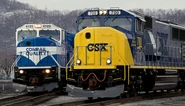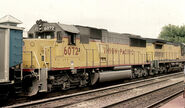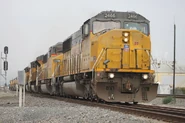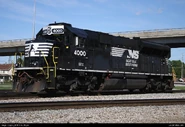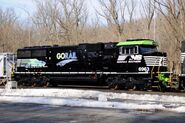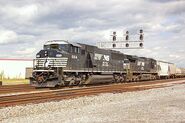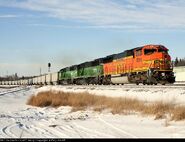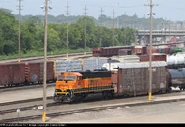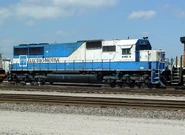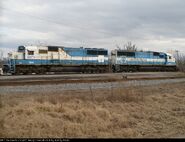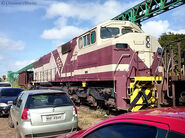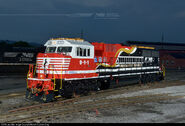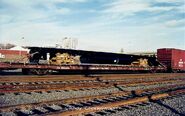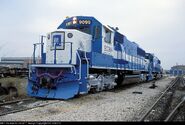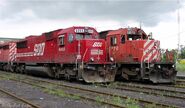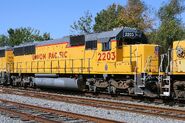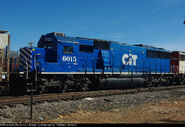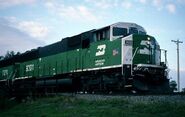The EMD (Electro Motive Division) SD60 is a type of six-axle, 3,800hp type of diesel locomotive built from 1985 to 1992 (although it was first introduced in 1984 and demonstrated until production was greenlit when orders were eventually received following the end of the 50 Series line production).
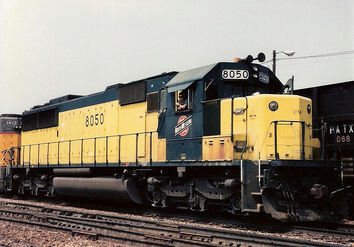
A CNW (Chicago And Northwestern) SD60.
1,140 were built, and most are still in service. Yet, many have been scrapped, rebuilt, or retired in favor of more modern, up-to-date AC-traction diesels such as the SD70ACe and ES44AC (besides more recent DC-traction models like the Dash 9 or SD70M which are generally favored or preferred on both western carriers; being BNSF and UP, whereas eastern carriers like CSX and NS still utilize SD60's for primary use).
Railroads such as the Chicago And Northwestern (CNW), Union Pacific (UP), Burlington Northern (BN), CSX, Conrail (CR), Norfolk Southern (NS), and the SOO Line are among the numerous customers who purchased fleets of the model for standard general revenue freight service. Oakway Leasing (through an agreement with BN) also ordered units for "power by the hour" services in case of power shortages, which were common on the road during the time.
Many of the remaining, unsold, former BN SD60M units owned by BNSF are currently used as heavy-duty rlad and yard switchers alongside the railroad's large fleet of SD40-2's and other preceding six-axle EMD models, where they are also assigned to local service.
History[]
First introduced in 1984 as a vast improvement to the otherwise far-fetched SD50 (which suffered terrible mechanical and electrical failures and issues similar to what occurred with the GP35 and SD45 in the 1960's), the SD60 was originally an attempt to
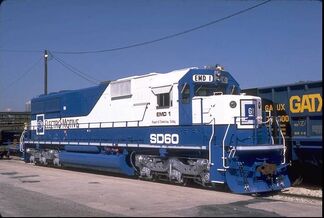
EMD #1: one of the four demonstrators built between May and June 1984. Said demonstrators were originally classified as "SD50A" before the SD60 name was given in 1985 after orders were first received with Norfolk Southern (NS).
rebound from EMD's previous losses with the plagued "50 Series" line. Intended for heavy-duty mainline freight service, the model was an attempt to garner more attention from potential buyers who kept looking towards GE's revolutionary "Dash 8" line, which was already undergoing development at the time of the SD60's debut. Later on in production, however, it eventually was intended to compete with GE's ever-dominate and high-tech C40-8 and its wide-cab counter-part: the C40-8W, which unfortunately took a large toll of the SD60's popularity away, resulting in sluggish sales and lost notoriety as the leading locomotive builder. Although, the introduction of the SD60 brought EMD back to its general roots for building commercially-successful and well-received models, it ultimately spelled the end of the mainline era for the four-axle road diesel market, yet the GP60 (it's four-axle counter-part) served as a final attempt (or a "last resort") to convince railroads to continue assigning four-axle diesels for high-speed intermodal service in hopes of receiving more profit to remain competitive with GE. Though, as a result of the declining popularity with four-axle road models, railroads ultimately preferred the use of six-axle diesels like the SD60 over traditional four-axle models for heavy-haul applications. Because of weight, tractive effort, fuel capacities, and other specifications being greater with most average six-axle diesels, most four-axle models in the past experienced different performances when in mainline service in comparison to their six-axle relatives. Thus, further resulting in four-axled units to be reassigned or retired completely from most railroads; especially those whom originally favored four-axled models as opposed to the increasingly-popular and dominate six-axled models. The SD60 was an initial success upon its debut, and completely dominated over the previous model in sales, performance, and popularity. It not only served as a drastic improvement over the previous model, but also introduced a handful of new features setting a new milestone for diesel locomotive technology. Such feature that was introduced was an improved and more advanced doppler radar-controlled "Super Series" wheel-slip
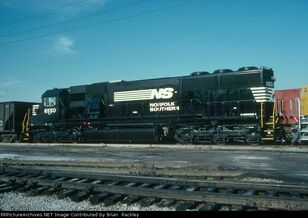
Freshly-painted and delivered from LaGrange, IL, NS #6550 was among one of the four early production SD60 units built, but also served as part of the second batch of preproduction testbeds for EMD. NS #6550-6553 (along with other early members of the class) were eventually rebuilt into PR43C's between 2010-2011.
system (a feature originally not included with most early Dash 8 models from GE, for they included basic "Sentry" wheelslip control systems), which eventually led to the further development of the technology EMD implimented with their current SD70 series. It was also the first model produced by EMD to use the newly-introduced and increasingly popular EMD 16-710G3A prime-mover from the 710 engine family, which was a drastic improvement over the otherwise flawed and overstressed 16-645F3 engine used on the SD50, and gave the SD60 an increased horsepower output (having 3,800hp) compared to its predecessor (having only 3,500hp to 3,600hp) as a result of featuring a larger displacement (having an 11-inch cylinder stroke and 710 cubic inches of displacement versus having only 645 inches; thus giving the distinct names of the engine types). Futhermore, the 710 engine (prime-mover or motor) model was an instant success; furthermore making it last far longer in production compared to EMD's 567 and 645 series engines from the past, despite not being fitted with nearly as many models or production units compared to its predecessors. The SD60 and the 710 engine's success (in-turn) led to the further development of subsequent models like the SD60MAC, and furthermore evolved and developed the SD70 series; with its updated and improved 16-710G3B and 16-710G3C engine models, which has remained in production since 1992.
In spite of its popularity, the model was completely outsold by the C40-8, despite desperate attempts to garner popularity with railroads.
SD60M[]
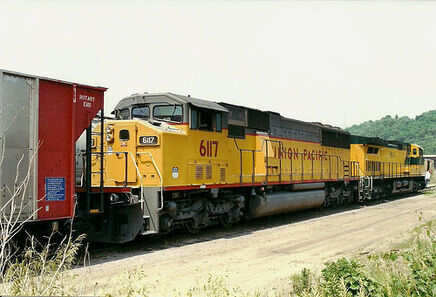
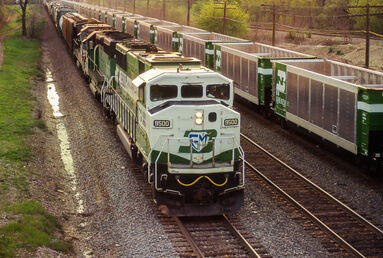
The SD60M ("M" meaning, "modified"); built between 1989 to 1995, is basically a modified version of the original SD60 only having a unique distinct cab which was first introduced in 1989 as part of the FRA's "Safety Cab" requirement for locomotive builders and Class 1 railroads (which took effect from 1988 to 1993). Furthermore, the cab itself was built to provide better safety during head-on collisions, providing an improved view for crews, and further reducing wind drag from operating at high speeds. Being one of the very first successful models (besides the C40-8W) of North American diesel locomotives to include a "North American Safety Cab", "Safety Cab", or "Wide Cab" variant, the cab style proved to be very effective (in contrast to its four-axle GP60M counter-part built a year later). The early, original design for the cab is often known and recognized for its unique, yet odd, look (often nicknamed "tri-clops" by railfans) reminiscent of the wide-cab and/or cowl-bodied Canadian-built units built for CN and CP, apart from utilizing the same nose style and window arrangement as the F59PH. In other words, the cab design was inspired by the "Canadian Safety Cab" concept (first devised by CN official William Draper in the 1970s), but was fully implemented by the United States Federal Railroad Administration as a mandatory safety policy for new domestic production locomotives manufactured in North America.
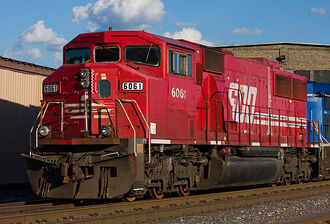
A SOO SD60M owned by the Canadian Pacific (CP Rail). Said unit was part of a five-unit order which supplemented a fleet of 58 standard-cab units that took place during the SOO-CP merger between 1989-1990.
Although successful at first (like the GP60M), the SD60M's "Phase 1" cab experienced numerous performance issues later-on during production. Many complaints from crews resulting in rattling, shaking, and faulty wiring caused the need for a much improved design which was introduced prior to the SD70M's introduction (in between the original SD70 and SD60MAC's trials and early production status) known as the "Phase 2" wide-cab, which was a vast improvement that eventually became more favorable with railroads, and such cab style has since been used on every North American wide-cab diesel locomotive built by EMD beginning with the later SD60M units ordered by the Burlington Northern in 1991 and ending with some of the last SD70MAC (or SD70AC) units built in 2004 (most employees actually favored the later "Phase 2" design as opposed to the previous "Phase 1" design found on earlier SD60M "tri-clops" units ordered by the railroad). Besides the cab, the electrical wiring (especially for the alternator) was arranged slightly differently than the original model.
Many are still currently in service with BNSF, CSX, and Union Pacific, though are in the process of becoming retired, de-rated, and/or reassigned to heavy-duty yard and local services (though, others such as Union Pacific's fairly large fleet; are currently in storage and are used as spare units awaiting additional service).
Several others owned by NS (Norfolk Southern) have been rebuilt into "Crescent Cab" SD60E units, or updated to SD60E specs (such as the ex-BN/BNSF SD60M units acquired from PRLX).
SD60I[]
The SD60I ("I" meaning, "isolated", "insulated", or "improved") was Conrail's version of the SD60M which provided a "comfort cab" or "whisper cab" which consisted of two seperate pieces separated by an insulated seam to reduce engine noises and vibrations which was (and still often is) apparent on many 710-era wide-cab diesels built by EMD.
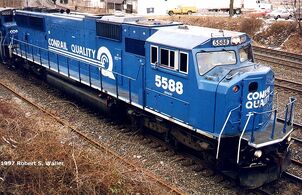
A typical Conrail SD60I.
They were orignally ordered upon request from EMD, though they were unable to assemble all the units for the road, for GMD London had a full-house of orders. Thus, the railroad ordered kits from the manufacturer, and began assembling a total of 81 units numbered from 5575 through 5654 (with one in particular; #5544, serving as a testbed or basis and ultimately being the first fitted with the new cab) between 1993-1995 at the company's Juniata Shops.
Many survived the Conrail Split of 1999, and have since been in service with CSX and Norfolk Southern since.
SD60F[]
North of the border, Canadian National (CN) participated in the development of the four SD50AF prototypes which eventually became the first SD60F's built. The SD60F is initially the improved, 710-equipped version of the SD50F, and is virtually indistinguishable from the previous model. In other words, 5500-5503 are pre-production SD60F's, originally classified as an "SD50AF", but were eventually reclassed and renumbered as CN 9900-9903. They look like SD50F's, but internally are SD60F's.
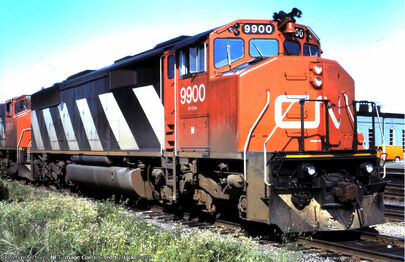
CN #9900 before becoming CN #5500.
CN took delivery of 64 units total between 1985 to 1989, and were numbered 5500-5563. Many have since been retired, yet some are still in active general revenue service.
SD60E[]
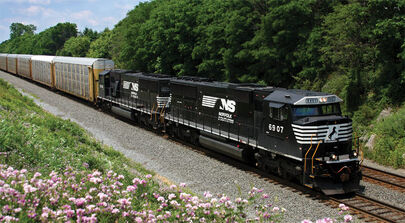
NS has currently been in the process of rebuilding all of their SD60 units into their own unique cab units designated as the "SD60E" ("E" for "Efficient", "Enhanced", or "ECO"), which are rebuilt standard-cab SD60 units consisting of having updated EM2000 microprocessor control systems, automatic fuel starters, enhanced dynamic braking grids, split-cooling systems, and unique cabs dubbed "Crescent Cabs" intended for better safety, reliability, visibility, comfort, etc. They are intended to be Tier 2/ Tier 3-compliant, and are guaranteed to last as long as the road's subsequent SD40-2 fleet.
NS has even acquired fleets of various lease standard-cab SD60 units (from UP and CNW heritage), which have also been rebuilt into said units.
Only a small handful of true, original, "conventional" or "standard cab" SD60 units remain on NS' roster which are yet to be rebuilt into SD60E's. All units are expected to be completed by 2019.
Many units have also been rated at 4,000hp.
Spotting Features[]
Despite being nearly identical to its predecessor, the standard-cab SD60 shouldn't be confused for said model. Some notable differences with the model are:
- Eight door panels below the radiator grilles as opposed six.
- Weather cover mounted on front radiator fan can be found on most units.
- Different number series for each owner.
Specifications[]
| Model | SD60 | SD60F | SD60M | SD60I |
|---|---|---|---|---|
| Production Dates | 1984-1991 | 1985-1989 | 1989-1993 | 1993-1995 |
| Total Built | 537 | 64* | 461 | 81 |
| Length | 71' 2" | 71' 2" | 71' 2" | 71' 2" |
| Wheel Arrangement | C-C | C-C | C-C | C-C |
| Engine | 16-710G3 | 16-710G3 | 16-710G3 | 16-710G3 |
| Horsepower | 3,800 | 3,800 | 3,800 | 3,800 |
| Alternator | AR11 | AR11 | AR11 | AR11 |
| Traction Motors | D87B | D87B | D87B | D87B |
| Weight x 1,000lbs. | 368,000-396,000 | 387,000-395,000 | 395,000 | 395,000 |
Note*: CN 9900-9903 were originally designated as an SD50AF, and still carry said designation on their builder's plates.
Trivia/Facts[]
The NS SD60E, is also practically the railroad's version of Conrail's SD60I.
Although the railroad was still independent during the placement of their later SD60 and subsequent SD60M orders, the SOO Line didn't receive their units until during the events of their merger with CP (Canadian Pacific) between 1989-1990. Thus, said units received a unique scheme dubbed as the "Candy Red" scheme (a modern version of the SOO logo with a CP-style livery) signifying the merger between the two carriers.
The BN (Burlington Northern) railroad only ordered three SD60 units (numbered #8300 to 8302) and were used as part of their "fuel conservation" project during the 1980's and were all painted in the BN's "Tiger Stripe" safety scheme; which was intended to make their locomotives more visible as a result of a fatal car accident which occurred years earlier.
All three of the BN's only SD60 units were eventually returned to EMD as a result of BN's agreement with Oakway Leasing (a leasing company which was once affiliated with EMDX leasing); having a long-term warranty to "borrow" fleets of their SD60 locomotives to use as needed in case of a "power shortage". The lease survived on into the BNSF merger and ended from 2006 to 2008. The SD60 units have since been auctioned off to various leasing companies, while some have since been acquired by CN.
Only a handful of ex-Oakway SD60 units still retain their original liveries and numbers.
The original three BN SD60 units are now in service with CSX as a result of a purchase in 2001, and have since been renumbered.
Railroads such as the Union Pacific and BNSF have their fleets of units currently left in storage (primarily their SD60M units). Though, BNSF recently reassigned their fleets of former BN SD60M units to be used for heavy-duty yard and local freight service.
Before the CNW's acqusition of their C40-8 fleet beginning 1987; along with the debut of the succeeding C44-9W in 1992-1993 (including its AC-traction counter-part a year later), the CNW assigned its SD60 fleet (along with their fleets of GP50 and subsequent SD50 units) to coal drag service in the Powder River Basin region in Wyoming; making the SD60 one of the last true conventional-cab DC-traction, six-axle diesel locomotives assigned to heavy-duty coal train service before ultimately being replaced by the latter GE diesels (considering that the CNW for the longest time was purely an EMD customer after the purchase of their last ALCO units and only acquired a handful of earlier GE diesel models and a fleet of subsequent U30C's prior to the debut of the C40-8).
When all three former BN SD60 units were returned to EMD, they began service as EMDX lease units; which were often commonly seen in EMD's Pueblo, Colorado testing facility and retained their original numbers, but were briefly renumbered numerous times.
CSX's earlier fleets of SD60 units were also painted in a variant of their "Grey Ghost" 'Stealth' scheme variant similar to their early C40-8 units; yet the SD60 units were painted with a brighter tone of blue, while the Dash 8 units were painted with italicized numbering.
NS #6548 (a former UP SD60 from CNW ancestry) is one of the several former HLCX lease units purchased to be rebuilt as part of the railroad's SD60E rebuild program (though, the majority of former UP/HLCX SD60 units owned by NS currently awaiting to be rebuilt are actually from CNW ancestry).CNW #8037 is another example of such units as listed above.
Several former BN (Burlington Northern) SD60M units were repainted into their successor's (BNSF Railway) Heritage 2 and Heritage 3 schemes; though one in particular (#8197) was painted in a prototype scheme during the early years of the railroad's formation.
Two NS SD60E units have received special liveries: one dedicating US military veterans (NS #6920), and one dedicating the "GoRail" rail development commission (NS #6963). A third unit, NS #911 (originally slated to be #7003), was painted in an livery dedicating first responding fire fighters (alongside NS #5642: a GP38-2 painted in a similar scheme months later).
Ironically, in an unusual move, NS acquired a handful of "tri-clops" SD60M units from BN heritage and utilizes them in primary service as opposed to rebuilding them into SD60E's.
Oddly, only one UP SD60M (UP #6165) wasn't renumbered when the railroad began to make way for their later AC4400CW units received from 2003-2004. Another unit (UP #6106) also retains its number, and is currently the only unit on the entire roster to not be part of any active sequential numbering series.
In early 2014, PRLX (Progress Rail Leasing) leased 5 ex-BNSF (nee BN) SD60M's (Nos. 8141, 8142, 8144, 8145, and 8148) to the B&P (Buffalo And Pittsburg) shortline. Progress Rail currently stores additional units if the railroad were to become interested in acquiring extra sooner or later. As of late-2014, the railroad is still deciding on whether to replace or supplement their existing fleets of older 645-series SD45, SD45T-2, and SD40T-2 EMD diesels from SP heritage.
In the early 1990's, Burlington Northern painted an SD60M unit in a unique and patriotic livery dedicating American troops during the Desert Storm war in 1991. The unit was eventually repainted and became BNSF 9299 sometime in 2001-2002, but was eventually renumbered 8199, and finally became 1476: a heavy-duty yard switcher wearing the "standard cab" variant of the H3 ("Heritage 3") scheme commonly worn on repainted yard and local units.
EMDX#3 (one of the 4 original SD60 demonstrators) was refitted with a prototype version of HTCR Radial BogieTrucks, to become standard on later EMD SD70 models, so to test and evaluate this revolutionary new BogieTruck design, resulting in a vast improvement over preceding HTC BogieTrucks. EMDX#3 eventually became GMTX#9041 then GMTX#9000, but retained the HTCR BogieTrucks.
Gallery[]
Sources[]
http://thedieselshop.us/Data%20EMD%20SD60.HTML
http://www.altoonaworks.info/rebuilds/ns_sd60e.html
http://www.amazon.com/Locomotives-Modern-Diesel-Electric-Reference/dp/1554078962
Videos[]
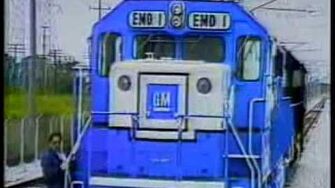
GM EMD SD60
SD60 introduction video.

